
THE VIEW FROM ANTWERP, OHIO
Rumble of trucks gives way to peace, quiet, and prosperity
Small-town residents glad to be bypassed by U.S. 24
4/13/2014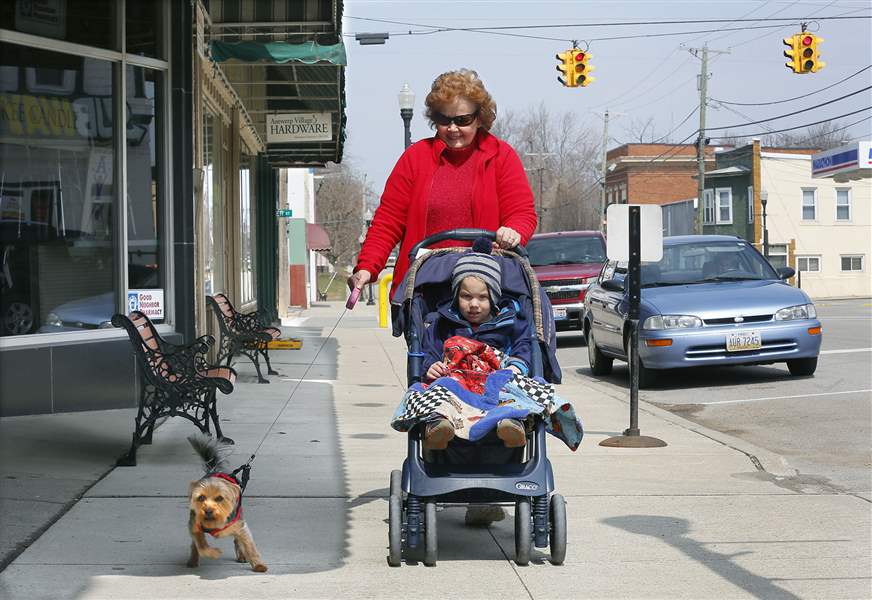
Anita Friend takes a stroll with her grandson Benton Rogge, 2, and her dog Lucy in downtown Antwerp.
THE BLADE/AMY E. VOIGT
Buy This Image

Anita Friend takes a stroll with her grandson Benton Rogge, 2, and her dog Lucy in downtown Antwerp.
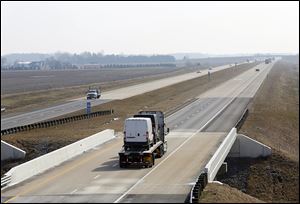
The new U.S. 24, shown stretching east near Texas, Ohio, has cut down on truck traffic in small communities along the old route.
ANTWERP, Ohio — Morning. Noon. Or night. It’s I-told-you-so-time in the community of Antwerp.
Gone is the daily parade of thousands of growling tractor-trailers cutting tight corners in this Paulding County town where today new businesses sprout like economic development directors’ dream scenes.
Without the highway hubbub, Antwerp is in its happy place, just as many predicted.
“Antwerp is safer and quieter,” said Village Administrator Sara Keeran. “It’s really wonderful without all those trucks. We are happy. The community is happier.”
For many years, the village was highway high-strung, stressed by safety concerns as pedestrians darted and dodged near bumper-to-bumper truck traffic wheeling along U.S. 24.
On Oct. 29, 2009, when the new U.S. 24 opened, Antwerp was bypassed, left behind in rear view mirrors as drivers trucked on down the new road.
PHOTO GALLERY: Click here to view images from around Antwerp, Ohio
Now, with a major reduction in traffic, safety worries have diminished. You no longer risk your life each time you try to cross the highway, several residents said.
“Kids can ride their bicycles,” said Anita Friend as she walked her Yorkie, Lucy, and pushed her 2-year-old grandson Benton Rogge in a stroller in Antwerp’s downtown.
“More people are out and about. They are not afraid to walk to get their groceries or get their mail,” she said. A local business owner, Mrs. Friend misses not the road runners’ ruckus.
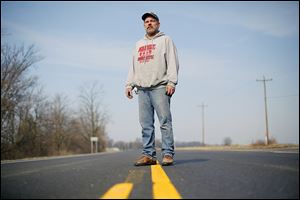
Matt Coger, in the middle of old U.S. 24 near Texas, Ohio, says the old route is now like a ‘country road.’
“Before, we couldn’t open our front door,” she said.
Residents can walk and talk along sidewalks. Before, they could not out-shout the trucks.
Mrs. Friend said more out-of-town — and out-of-state — customers are finding their way to Antwerp to shop. Stand tiptoe on a towering grain silo and you can see Russia — no, we do mean Indiana, three or so miles from the village limits.
Population 1,700 today, the small, viable village was surveyed and platted in the early 1840s and incorporated in 1864. It was built on and around the already-established Wabash & Erie Canal and along the Maumee River. Railroad service by a precursor to the Wabash Railroad developed in the mid-1850s.
The community quickly developed as an important commerce point. Years later, trucks mostly replaced the trains that replaced the boats, and the town turned into a way-station of sorts for traffic that roared east and west on U.S. 24 and the north-south State Rt. 49.
U.S. 24 is a major shipping route in northwest Ohio, with trucks representing one third of traffic. Expansion of U.S. 24 into a four-lane divided highway was designed to alleviate safety concerns caused by the mixture of truck traffic and residential travel along what is commonly called the old 24.
Cussed and discussed, the proposed new sections of U.S. 24 riled up residents off and on for decades, particularly at community meetings when site maps were unveiled. Ready for some fussin’ and a feudin,’ residents cried out “Not through my front door” or “Not across my farmland.”
Certainly safety as a priority was applauded, even as taking prime farmland triggered opposition.
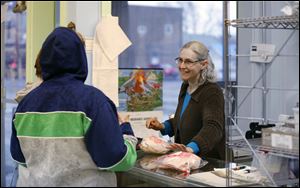
Diana Watson, right, co-owner of Hometown Pantry in Antwerp, assists customer Tiffany Dix of Hicksville with an order. Ms. Watson and her husband opened the store in 2011 after the U.S. 24 bypass was built.
Getting it done
Eventually, attempted road blocks failed to halt the $500 million-plus project in Ohio and Indiana. Plans turned into reality, and then the earth moved.
U.S. 24 construction began in 2004 with a project to complete the four-lane bypass around Defiance. Widening of the 13-mile stretch between Napoleon and Defiance was finished in 2008, and 26 miles of new roadway between Defiance and Indiana Rt. 101 opened a year later.
In 2008, construction started between Napoleon and Waterville. The bypass around Waterville was estimated to remove from the community’s traffic pattern many of the 5,000 trucks that used U.S. 24 each day.
On Aug. 29, 2012, people gathered near Waterville to celebrate the culmination of a half-century of planning and on-and-off controversy and struggles. The $169 million, 21.5-mile, four-lane highway between the north side of Waterville and the east end of U.S. 24’s Napoleon bypass replaced 23.5 miles of two-lane roadway notorious for serious, and often fatal, crashes involving big trucks.
Now, in spring, 2014, it’s still a highway divided. Pluck off the petals: I love it, I love it not.
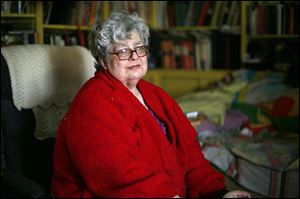
Sandra Kay Temple, editor of the Antwerp Bee-Argus, says that overall, the U.S. 24 bypass makes ‘the residents feel better.’
Balancing act
In Antwerp, officials tightrope walk to balance business growth. A 64-acre parcel in the town’s southern section near a bypass exit is a prime let’s-pull-over-for-gas-and-coffee site.
Whoa. Wait a minute, say some Antwerp residents. Don’t kill off the downtown by giving birth to new development that encourages motorists to dart off and back onto the new highway.
Mrs. Keeran agreed officials must be cautious as plans proceed for new development.
June L. Temple, 92, an expert on the town’s past, frets about its future. Ink in her veins, she shoulders responsibility.
“A town is only as good as its newspaper,” Mrs. Temple, publisher of the Antwerp Bee-Argus, has long said.
She wavers on bypass pros and cons. “We’re still hanging in there. Some feel it might be a good thing, but I think maybe it could end up hurting small towns.”
Since 1958, the Temple family has published the paper. Mrs. Temple’s popular Tales and Legends column is missing from some issues.
“Mom hasn’t felt much like writing lately,” said daughter Sandra Kay Temple, the paper’s editor. In a nearby room in the Temples’ home, a police scanner crackles with emergency calls. “We keep track of the news in the county with that scanner,” she said.
And the family tracks the town’s mood. Overall, Ms. Temple said, the bypass “makes the residents feel better.”
Bryce Steiner, president of West Bend Printing & Publishing Inc., agreed, noting the community is better off because of the bypass. “It has been a Godsend,” he said.
Safety fears were very real for a very long time, he said, particularly because the three traffic lights designed to slow traffic “just made the trucks want to go faster, 40 or 50 miles per hour, to beat the lights,” Mr. Steiner said. A daily traffic count a few years back showed 8,000 trucks wheeling through Antwerp on one day, he noted.

A sign marks the entrance to Florida, Ohio, a community of 230 people in Henry County and one of the communities along the old U.S. 24.
An interesting mix
Spend some time here and you can see it: The close-knit community cares. About their town, about their neighbors. Antwerp is an interesting mix of old and new, trendy and vintage, the usual and the unusual.
At the Hometown Pantry, a cowbell jangles, announcing customers.
Opened in 2011, the business is doing fine. “We get people traveling from Fort Wayne to Toledo who stop in here. It’s a lot easier to get around Antwerp now that there’s the bypass,” said Diana Watson. She and her husband, Tony, own the store and next-door ice cream shop.
The pantry is reminiscent of old-time general stores, but with a twist, catering to growing demand for food stuffs closer to the farm than the factory.
Containers of couscous, quinoa, and flax meal share shelf space with old-fashioned root beer hard candies, chocolate malt balls, and maple nut goodies. It truly is a soup-to-nuts market.
As Mrs. Watson shows off specialty teas, she lists who’s who, what’s new. “We’re new. The gun shop is new. A coffee place is new. We just got a chiropractor. We now have a new dine-in pizza place,” she said.
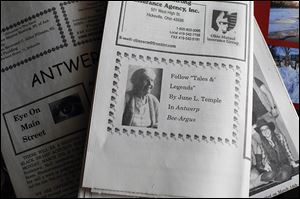
The column of June L. Temple, publisher of the Bee-Argus and an expert on Antwerp’s past, is promoted in the paper. Ms. Temple, 92, seems undecided on bypass pros and cons.
Other towns
Many residents along or near other sections of old 24 embrace the new-found peace and quiet as well as a bloom in business.
Credit the fast break.
Motorists jump on the bypass, sprint along at 70 mph — or faster, mostly faster — and arrive at their destinations in mere minutes.
“The bypass has made a big difference,” said Velma Hull. She and her husband, Randy, are owners/operators of Centsible Treasures in the Henry County village of Liberty Center, just a mile off the new U.S. 24. “We get a lot of people from Waterville, Sylvania, Toledo, Maumee, Perrysburg because it’s a quick trip for most people.”
Councilman Roger Fisher noted more heavy tractor-trailers seem to be using the town’s main drag as a thoroughfare from industries in the Delta area to the Liberty Center exit, creating stress on State Rt. 109. Although pleased about area industry, he said it’s the old “same thing that works for you works against you” scenario.
In now-bypassed communities of Texas and Florida, the glint is gone from these one-time thriving canal-town gems. Some businesses in Texas, for instance, closed decades ago.
However, at Scenic View Apartments, damaged by fire last fall, construction is under way to get five rooms ready for tenants. Contractor Matt Coger of MAC Construction in Wauseon, who is handling the renovation work, recalled the years when it was a scary squeeze for motorists who had to turn onto the truck-packed U.S. 24.
Mr. Coger puts down tools. He takes a few paces and stands in the middle of the highway, gazing at the nearby cappuccino-colored Maumee River. “It’s like a country road now,” he said, looking both ways along the old 24 — nary a vehicle in sight, there in Texas, a town with several dozen or so residents.
“Before the bypass it was truck after truck. Vroom, vroom, vroom. Nothing but lines of semis going back and forth.” Now, people can sit on their porches and talk. Lounge on their decks and talk, he said.
Ditto in the village of Florida, population about 230. At the Florida Miami & Erie Market, a No Pets Allowed sign is displayed prominently near a sign that says, “My dog has created more shovel ready jobs than Obama.”
Working behind the counter, Hope Link of Ayersville says business soars in the summer but chills out in the winter now that most trucks shifted gears to the new U.S. 24.
Summertime brings the bicyclists, the motorcycle riders, the recreational crowd. People boat, they fish. They watch the eagles.
Daniel Bejarano, 15, who lives along old 24, says sleeping is a breez-z-z-z-e. “It’s so much quieter,” he said.
Neighbor Lola Helmke said, “It’s peaceful now. No truck traffic. Yeah, it’s great. I can sleep with my windows open. My house faces 24. I can sit out on my porch. People stop by and talk.” That didn’t happen when truck traffic barreled through the village. “It’s now a quiet small community.”
Area parks are in the mix too when it comes to embracing bypass by-products.
The bypass has been terrific for the Metroparks of the Toledo Area. “Turning into and out of our three parks along the river is safer now, and the experience of riding the canal boat at Providence Metropark or walking the Towpath Trail at Farnsworth Metropark is greatly improved without the sound of heavy traffic. Our living history interpreters who operate the canal boat used to have to yell over the traffic noise where the canal boat passes through a lock, near the Isaac Ludwig Mill. Now, it’s a more pleasant experience,” Scott Carpenter, the Metroparks’ spokesman, said.

Downsides
Indeed, some bypass naysayers are still saying nay. Consider people living in what could be described as “stubdivisions,” areas with dead-end roads, a result of the location of the new U.S. 24.
Residents near the stubs must go out of their way to get to where they want to go. It’s a time-consuming pain, griped one resident, declining to give a name because the bypass issue still fuels flames of discontent. It’s easier to pipe down than speak up.
In nearby Waterville, business is brisk at the Silver Lining Gallery, featuring hand-crafted work of more than 200 local artists. “In fact, now that there is no longer a constant stream of traffic going through the center of Waterville, the roadway has become much safer,” said co-owner Lisa Exner. “We have people telling us that they are more willing to make the drive to downtown Waterville due to this. The traffic noise and congestion is greatly diminished, helping to restore the quaint village atmosphere of downtown Waterville.”
Bypassed communities, however, seek beacons, arrows of attention. Signs. Towns want signage.
Waterville, now a city, is addressing the need for signage to draw people into the historic community.
The bypass has worked well in cutting down on noise downtown from near constant truck traffic, Waterville Administrator Jim Bagdonas said.
Location: Paulding County, Ohio
Population: 1,700
Incorporated: 1864.
Named after: The Belgian city of Antwerp, named in the 4th century and a strategic port city during World War II. It was occupied by German forces from 1940 to 1944, when it was liberated by the Allies.
Why “Antwerp”: The area was first settled in the late 1820s, and the town was surveyed and platted in 1841, according to AntwerpOhio.com, the community Web site of the village. The town’s founder set out to give it a name that no other community in the United States already had and came up with Antwerp, after the city in Belgium.
That noise wasn’t silenced, however. It moved. And some area residents, displeased about traffic noise near their homes, have asked the Ohio Department of Transportation to conduct noise measurements, he said.
ODOT has been working with a group of local officials and community members from Waterville and Monclova and Waterville townships about noise along the new alignment. ODOT plans to get readings soon to determine current sound levels along U.S. 24, said Theresa Pollick, spokesman for ODOT’s District 2. After a review of data, ODOT will determine if action is warranted, she said.
Meanwhile in Waterville, development continues near the State Rt. 64 exit where a new filling station is being built. The city has issued zoning permits for a 30,000-square-foot retail commercial complex northeast of a new Kroger. The building is to house a facility of the University of Toledo Medical Center, formerly the Medical College of Ohio, as well as restaurants and a hair salon, for starters.
The old 24 — it will be called that for years — steers traffic near, but not through, the village of Grand Rapids. So far, said Administrator Chad Hoffman: “I have had no feedback at all from business members or village council” about the new 24.
A scenic byway
Area residents who travel along the old 24, he said, are noticing more and more bicyclists along the paths of pavement less traveled.
Pencil in on your to-do list: Take a trip along old 24, a nearly truck-free scenic byway.
Listen to whispers of spring. Rat-a-tat-tatting of woodpeckers. Spinning spools of kite string. Babbling waterfalls, white with foam.
Be alert: Squirrels claim the old 24 as their own. Woe to motorists who dare to trespass on their turf. Giving the ’ol stink eye, the nut-crunching critters reluctantly move. Tails swish with indignation.
You almost expect to see “Take The Bypass” gnawed into the bark on a nearby tree.
Contact Janet Romaker at: jromaker@theblade.com or 419-724-6006.